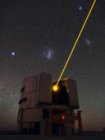Gamma-Ray Astronomy with the HAWC Observatory
Gamma-Ray Astronomy with the HAWC Observatory
Francisco Salesa Greus and the HAWC Collaboration
The High-Altitude Water Cherenkov Observatory (HAWC) is a TeV gamma-ray detector located at 4100m a.s.l. on the slope of the Sierra Negra volcano in Puebla, Mexico. The detector, completed in early 2015, consists of 300 water Cherenkov detectors (WCDs) spread on a 22000m2 area. Each WCD is instrumented with four photo-multiplier tubes used to detect energetic secondary particles produced after the interaction of a primary cosmic ray or gamma-ray with the atmosphere. HAWC observes two thirds of the TeV sky every day and it is sensitive to primary particles with energies from several hundred GeV to a hundred TeV. Some of the HAWC scientific goals are to study the Galactic sources at high energies, extended sources, diffuse gamma-ray emission, and transient emission from Active Galactic Nuclei (AGNs) and Gamma-Ray Bursts (GRBs).The recent results from the experiment and the future plans of the collaboration will be discussed in this paper.
Proceedings of the Polish Astronomical Society, vol. 7, 316-321 (2018)
Download full article as PDF file:







